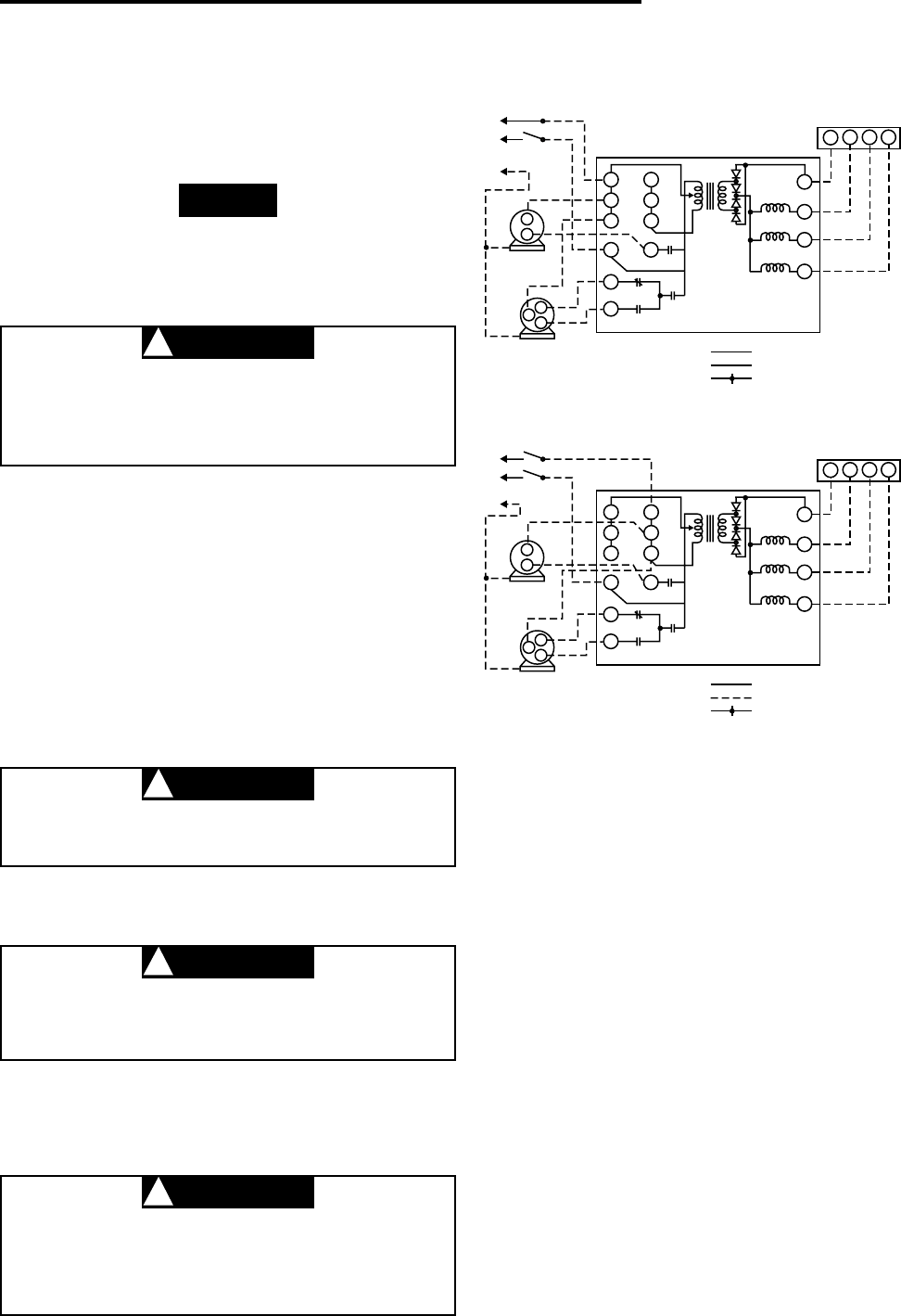
3
INSTALLATION (cont’d)
5. Select an appropriate location for mounting the con-
trol. Position the case on a smooth flat surface in a
vertical position only (with electrical knockouts down).
Mount the case using flat washers and screws (not
provided) through the four mounting holes in the back
of the case.
Install conduit, then run wiring and install the thermostat
according to thermostat installation instructions (included
with thermostat) before installing panel assembly in case.
Non-metallic enclosure does not provide ground-
ing between conduit connections. Use grounding
bushings and jumper wires to ensure proper
grounding of control.
6. After wiring is run into case, bend the wires out slightly
so that the wires will be in front of the panel assembly
when it is installed.
7. Loosen the three panel mounting screws in the case
approximately one turn. Slide the two slots located at
the top of the panel assembly under the two mounting
screws at the top of the case. Lower the panel assem-
bly into the case until the bottom mounting screw
protrudes through the keyhole slot on the panel. Slide
the panel assembly up toward the top of the case, then
hold the panel assembly in place while tightening all
three mounting screws.
Do not over tighten panel mounting screws to
avoid damage to the panel assembly.
8. Connect wires to proper terminals (see fig. 4 for typical
wiring connections).
Do not press against panel assembly while tight-
ening terminal screws to avoid damage to the
panel assembly.
9. Replace cover and test operation per the checkout
section.
WIRING
To prevent electrical shock and/or equipment
damage, disconnect electric power to system at
main fuse or circuit breaker box until installation
is complete.
NOTE
CAUTION
!
CAUTION
!
CAUTION
!
All wiring should be done in accordance with local and
national electrical codes and ordinances.
CHECKOUT
1. After mounting and wiring has been completed, set
thermostat switch to “OFF” position and fan switch to
“LO” position. Turn thermostat lever to “5” and thermo-
stat switch to “COOL”. Nothing should happen pro-
vided the room temperature is below 95°F.
2. Turn thermostat lever to “1”. The pump should start
immediately, provided the room temperature is above
55°F.
3. After a time delay of 30 to 120 seconds to allow the
cooling pads to become soaked, the fan should start
running at low speed.
4. Turn fan switch to “HI” position. The fan should now be
operating on high speed.
5. Turn thermostat switch to “VENT” position. The pump
should stop immediately.
6. Turn the thermostat switch to “OFF” position. After a
delay of 3 to 30 seconds, the fan should stop running.
CAUTION
!
N
P2
F2
L1
PUMP MOTOR
(120 V)
2-SPEED FAN
(120 V)
L0
HI
L0
HI
P1
L2
P2
F2
W
Y
G
R
R
W Y G
PUMP
RELAY
PUMP
RELAY
LO SPEED
FAN
HI SPEED
FAN
FAN SPEED
RELAY
FAN TIMER
RELAY
FAN
TIMER
RELAY
120V
HOT
GND
COM
N
120V
240V
120V 240V
120V 240V
1F51-619 or 1F51W-619 THERMOSTAT
8A18Z-2
INTERNAL WIRING
FIELD INSTALLED WIRING
ELECTRICAL CONNECTION
120 VAC DIAGRAM
N
P2
F2
L1
PUMP MOTOR
(240 V)
2-SPEED FAN
(240 V)
L0
HI
L0
HI
P1
L2
P2
F2
W
Y
G
R
R
W Y G
PUMP
RELAY
PUMP
RELAY
LO SPEED
FAN
HI SPEED
FAN
FAN SPEED
RELAY
FAN TIMER
RELAY
FAN
TIMER
RELAY
120V
HOT
GND
COM
HOT
240V
240V
120V 240V
120V 240V
1F51-619 or 1F51W-619 THERMOSTAT
8A18Z-2
INTERNAL WIRING
FIELD INSTALLED WIRING
ELECTRICAL CONNECTION
L1
L2
240 VAC DIAGRAM
Figure 4. Typical wiring diagrams








